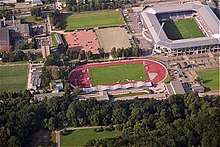Ostseestadion
The Ostseestadion is the home stadium of F.C. Hansa Rostock, a German association football club, located in the city of Rostock. It has a capacity of 29,000.
 | |

| |
| Full name | Ostseestadion |
|---|---|
| Former names | Ostseestadion (1954-2007) DKB-Arena (2007-2015) |
| Location | Rostock, MV, Germany |
| Owner | Ostseestadion GmbH & Co. KG |
| Operator | Ostseestadion GmbH & Co. KG |
| Capacity | 17,000 (1954) 25,500 (1991 expansion) 29,000 (2001 expansion) 25,000 (seating) |
| Field size | 105m x 68m |
| Surface | Grass |
| Construction | |
| Broke ground | 1953 |
| Opened | 4 August 2001[1] |
| Renovated | 1991 April 2000-August 2001 |
| Construction cost | 55 million DM (2000-2001) |
| Architect | Beyer + Partner, Rostock |
| Tenants | |
| F.C. Hansa Rostock | |
"Ostseestadion" translates in English to "Baltic Sea Stadium", and is named after the Baltic Sea, whose coast Rostock lies upon. Ostseestadion is the original name of the stadium, but on 2 July 2007, Hansa Rostock sold the naming rights for the following 10 years to Deutsche Kreditbank (DKB), hence the new official name became "DKB Arena". In 2015, the club announced that the stadium was to regain its original name, and that the DKB had allowed an early renaming of the stadium and agreed to end the naming contract in advance.[2]
Location

The Ostseestadion is located in the German city of Rostock in the state of Mecklenburg-Vorpommern. Within Rostock, it is situated not far from the city centre in the Hansaviertel part of town near several hospitals of the University of Rostock and a small forest called Barnstorfer Wald'. Moreover, an ice hockey stadium as well as several training pitches of Hansa Rostock are just adjacent to the Ostseestadion.
The stadium can be reached easily from all parts of Rostock by public transport, using buses (stop Ostseestadion) or the S-Bahn (stop Holbeinplatz). Public transport is free with a valid ticket for a home match three hours before and two hours after the actual match.
History
The stadium was newly built in 2001 on the site of a former stadium built in 1954. At the end of the 1960s a new 700 lux lighting system was added, which is still in use today.
Seating

The total capacity of 29,000 places includes 1000 "business seats" as well as a standing capacity of 9,000. During international matches the 9,000 standing places can be turned into 5,000 seats thus allowing for an audience of 25,000. Moreover, there are 26 business lounges for premium partners and sponsors.
Internationals
| 26 September 1954 | |||
| – | 0:1 (0:1) | ||
| 29 June 1958 | |||
| – | 1:1 | ||
| 30 October 1960 | |||
| – | 5:1 | ||
| 9 July 1967 | |||
| – | 7:0 | ||
| 6 September 1970 | |||
| – | 5:0 | ||
| 31 May 1972 | |||
| – | 0:0 | ||
| 23 May 1974 | |||
| – | 1:0 | ||
| 7 May 1980 | |||
| – | 2:2 | ||
| 27 March 2002 | |||
| – | 4:2 (1:1) | ||
| 7 October 2006 | |||
| – | 2:0 (1:0) | ||
Gallery
- Main entrance
 Rear entrance
Rear entrance Interior
Interior
References
- http://www.fc-hansa.de/fakten.html
- "DKB ermöglicht vorzeitige Umbenennung - Hafen der Kogge heißt wieder Ostseestadion". fc-hansa.de (in German). F.C. Hansa Rostock e.V. 13 May 2015. Retrieved 2 August 2015.
External links
| Wikimedia Commons has media related to Ostseestadion. |
- http://www.dkb-arena-rostock.de official page
- http://www.fc-hansa.de F.C. Hansa Rostock club page